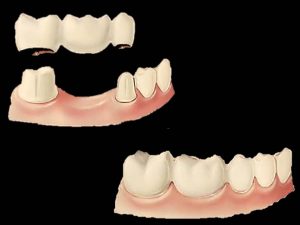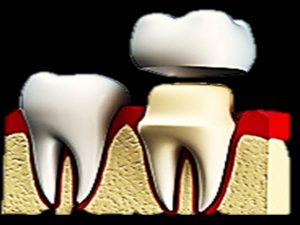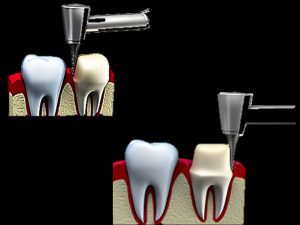Crown and Bridge
Restorations replacing your missing teeth
A crown is the common name given for a dental restoration that covers or encloses completely, a weakened, damaged or decayed top portion of the tooth and restores it to its natural form and function. A few common indications that necessitate a crown are, if a tooth has broken or cracked, decayed, or if other more conservative restorations have failed and the decay has spread, or if the tooth has discoloured due to trauma. A dental crown also serves as a protective restoration and enhances a tooth’s longevity of bearing chewing forces and structural integrity, particularly after a root canal restoration or after a large cavity has just been filled in a tooth. In addition to the dental crown restoring the tooth’s function they also give you an aesthetically pleasing look.

On the other hand, a dental bridge refers to a series of conjoined crowns that functions to replace one or more missing teeth. The teeth adjacent to the missing teeth are crowned (covered with a crown) and these crowns act as anchors for the replacement tooth / teeth (pontic) which therefore bridges the gap left by the lost teeth and fills in the space in the dental arch.
We could give you a choice of a variety of dental bridge procedures and can help you determine which treatment is right for you. Dental crowns and bridges can be attached to either natural teeth or sometimes, a dental implant which was placed in the space of the missing tooth. We design these crowns so that they perfectly match the size, alignment, and appearance of your natural teeth so as to give you best aesthetics.

Crowns and bridges require a procedure called tooth preparation which involves shaping of the tooth (or the adjacent teeth next to your missing tooth) to receive a crown and then the supporting crowns are thereafter cemented on these prepared teeth. The tooth that you lost is replaced by the artificial tooth in the centre. We will work together with you to select the colour, shape, and size of your restorations.

After the tooth is trimmed, impressions (a mould) are taken, a model is made using the impression and the crown is fabricated to fit over the trimmed tooth on this model of your teeth. In the meanwhile a temporary restoration will be placed to protect your natural teeth while your crown or bridge is being created. The final crown or bridge after it is fabricated in the lab is then cemented or bonded to complete the restoration of the tooth.
Do You Need a Dental Crown?
You need a dental crown if:-
You have a discoloured tooth as a result of some trauma due to a fall, or hit etc.
You absolutely have to protect a tooth that has been weakened by a large decay or after root canal treatment
If you have a cracked or broken tooth
When Do You Need a Dental Bridge?
If you have one or more teeth which are missing, a fixed dental bridge can prevent your remaining natural teeth from shifting into the space left by your lost teeth. Such a gap between your teeth affects the whole integrity of the dental arch much like a string of pearls or a chain which has been cut could easily disintegrate to pieces. Leaving the missing teeth unrestored could severely impact your overall dental health and facial aesthetics. A dental bridge therefore replaces your missing teeth and recreates a full set of teeth thereby restoring the original health and functionality of your mouth.
Dental bridges provide a permanent and fixed alternative to removable partial dentures or complete dentures and can be maintained with regular oral hygiene practices. A partial removable denture takes support from the neighbouring teeth adjacent to an edentulous area and in due course of time can weaken those teeth.
You could choose Porcelain or a ceramic crown if you want to cover a chipped or fractured front tooth. However for a back tooth you may wish to select a metal or zirconia crown. Porcelain or ceramic crowns are translucent and provide a very natural lifelike appearance.
Thin wafer like minimally invasive restorations called veneers are the restoration of choice for aesthetic improvements for chipped or slight surface-decay of your front teeth. Porcelain veneers require very less preparation or shaping of your natural tooth structure and are bonded or stuck to the surface of your natural teeth. These veneers or laminates derive strength from the remaining tooth structure. However, if we diagnose you as a person who is accustomed to be habitually clenching and grinding your teeth (often unknowingly), then a veneer might not sustain that kind of chewing forces and then we may suggest you to go for aesthetic porcelain crowns.
But if your teeth are rendered weak by extensive decay or is fractured we may advise you to choose a crown instead.
For your very back teeth, which may not be visible at all, you could choose to have a metal crowns which might be silvery or gold (made from alloys of gold). Such metal crowns are strong and durable and do not chip or break. They do not wear or abrade away the enamel of the other teeth. They however have a shiny metallic appearance, and the only place they could be considered is the very last molars of you lower jaw.
